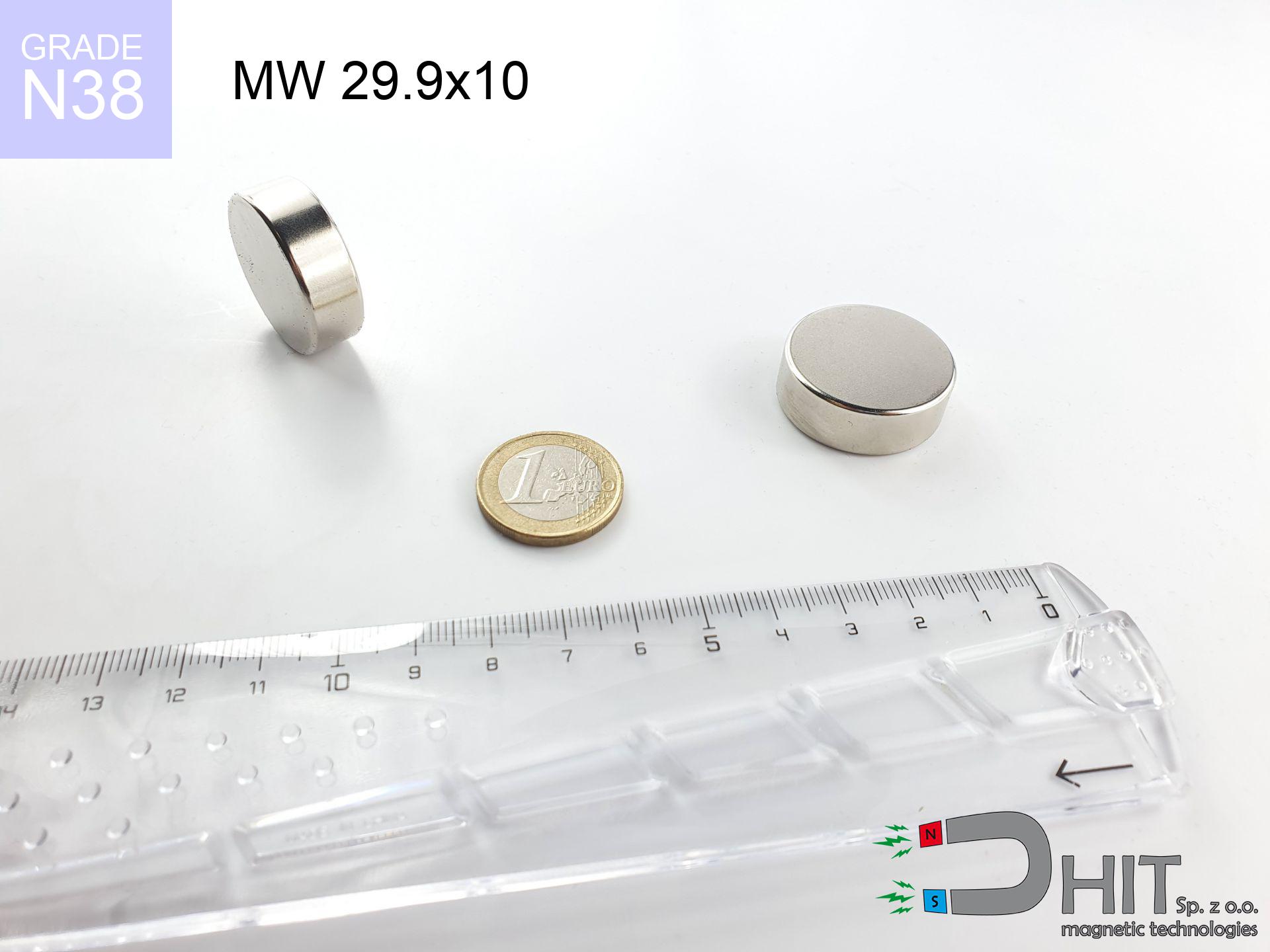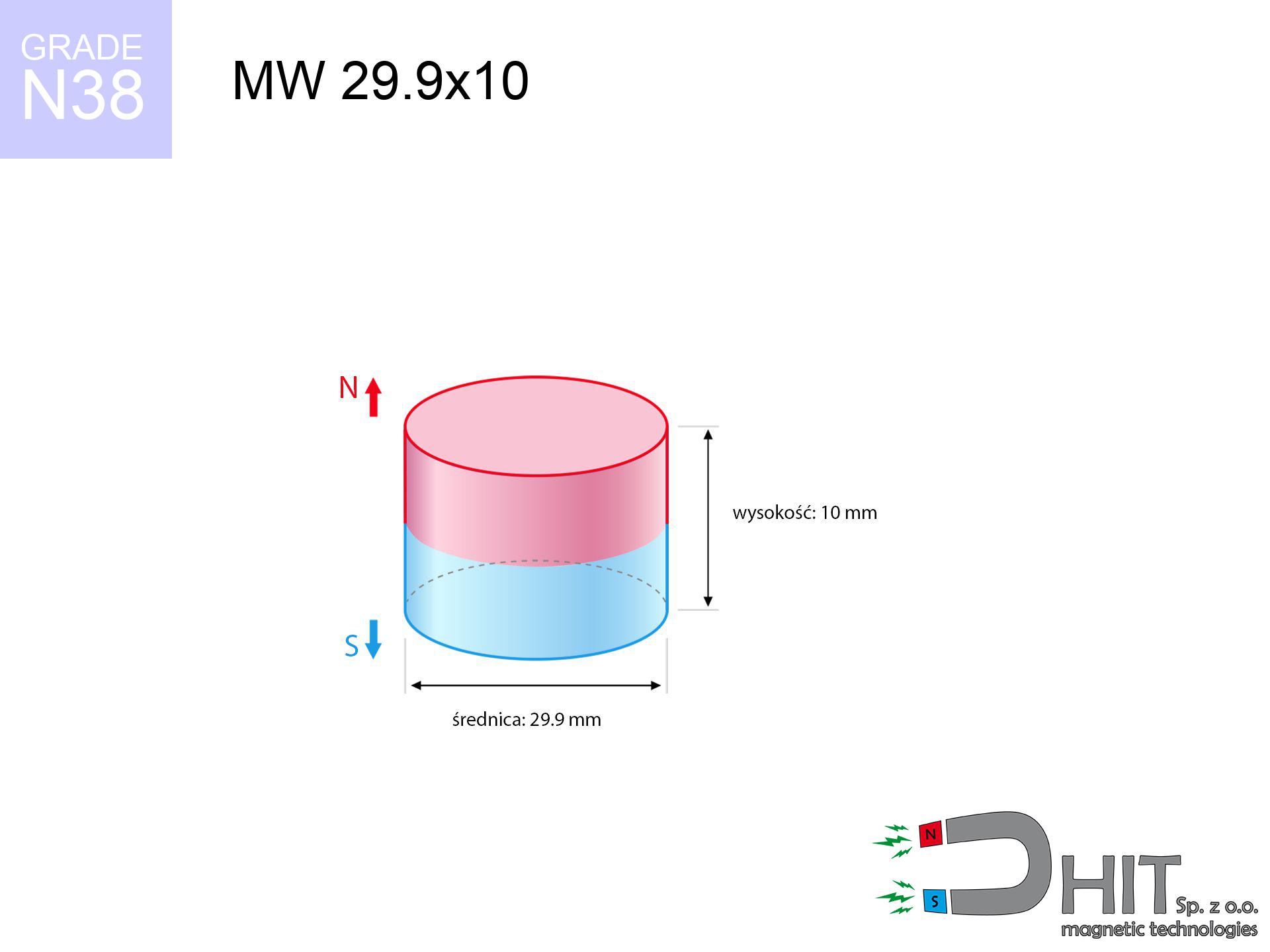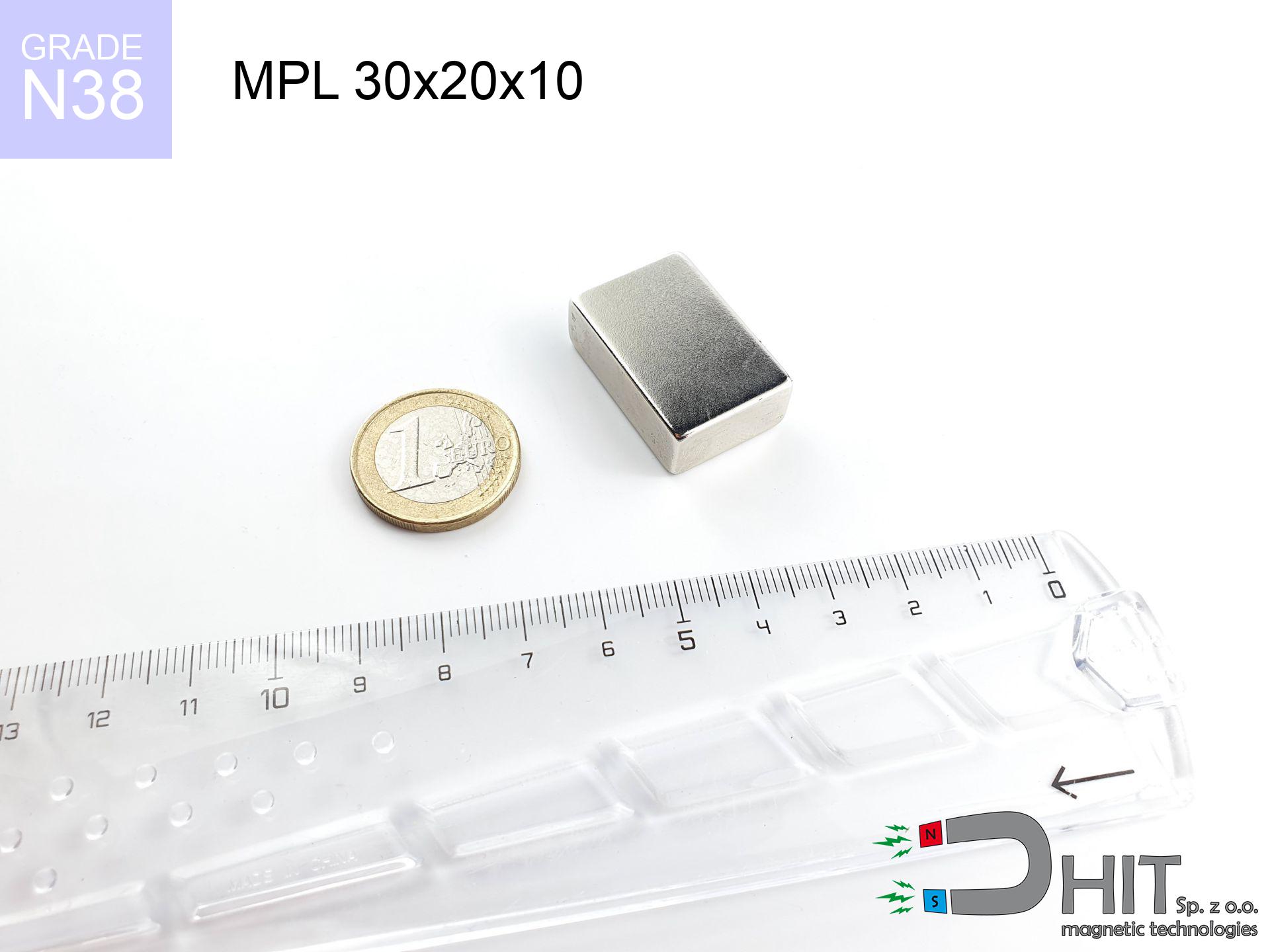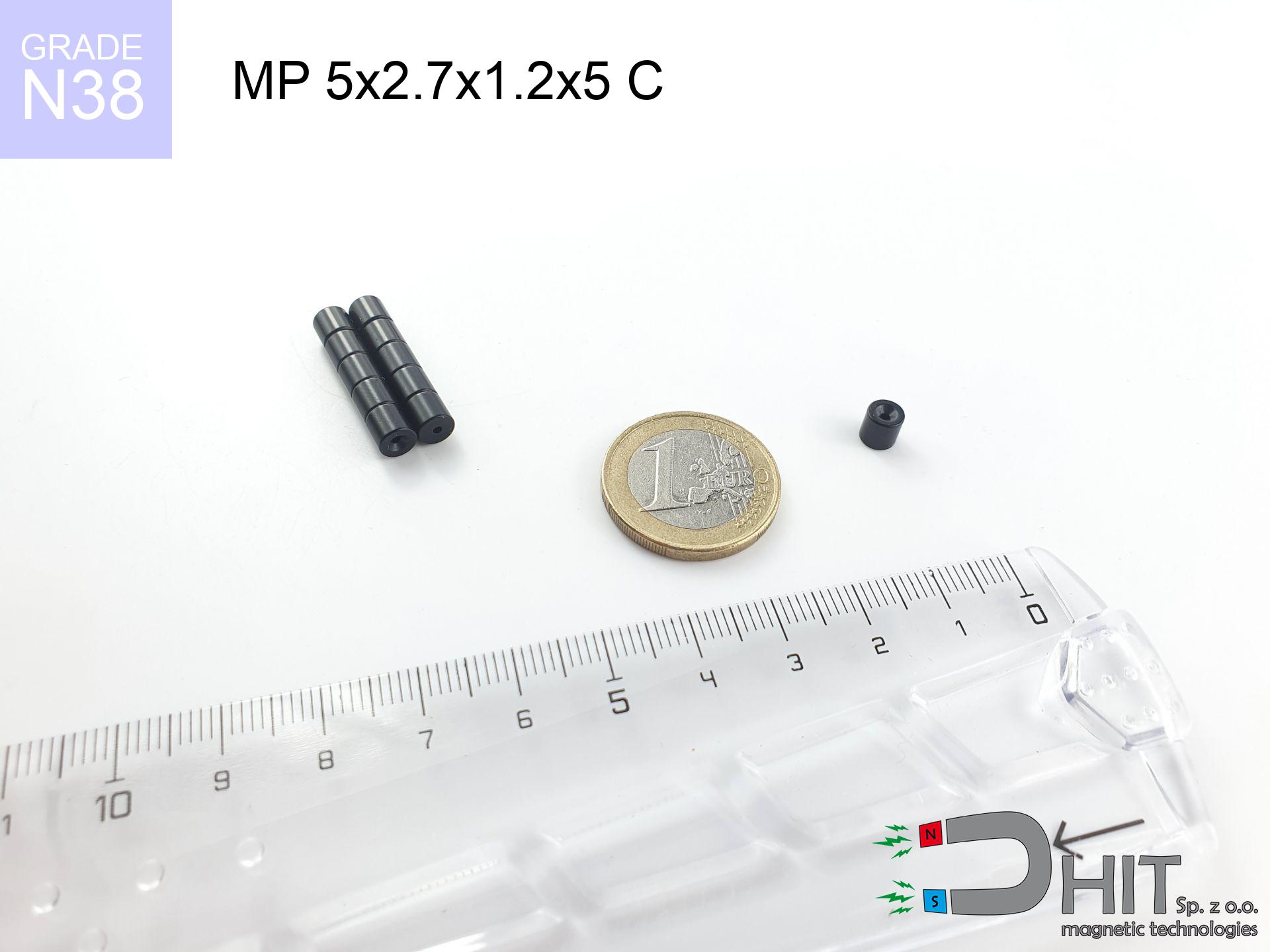MW 29.9x10 / N38 - cylindrical magnet
cylindrical magnet
Catalog no 010052
GTIN/EAN: 5906301810513
Diameter Ø
29.9 mm [±0,1 mm]
Height
10 mm [±0,1 mm]
Weight
52.66 g
Magnetization Direction
→ diametrical
Load capacity
21.50 kg / 210.90 N
Magnetic Induction
344.60 mT / 3446 Gs
Coating
[NiCuNi] Nickel
24.60 ZŁ with VAT / pcs + price for transport
20.00 ZŁ net + 23% VAT / pcs
bulk discounts:
Need more?Not sure what to buy?
Pick up the phone and ask
+48 22 499 98 98
otherwise contact us via
inquiry form
the contact section.
Lifting power as well as form of magnetic components can be estimated on our
force calculator.
Order by 14:00 and we’ll ship today!
MW 29.9x10 / N38 - cylindrical magnet
Specification / characteristics MW 29.9x10 / N38 - cylindrical magnet
| properties | values |
|---|---|
| Cat. no. | 010052 |
| GTIN/EAN | 5906301810513 |
| Production/Distribution | Dhit sp. z o.o. |
| Country of origin | Poland / China / Germany |
| Customs code | 85059029 |
| Diameter Ø | 29.9 mm [±0,1 mm] |
| Height | 10 mm [±0,1 mm] |
| Weight | 52.66 g |
| Magnetization Direction | → diametrical |
| Load capacity ~ ? | 21.50 kg / 210.90 N |
| Magnetic Induction ~ ? | 344.60 mT / 3446 Gs |
| Coating | [NiCuNi] Nickel |
| Manufacturing Tolerance | ±0.1 mm |
Magnetic properties of material N38
| properties | values | units |
|---|---|---|
| remenance Br [min. - max.] ? | 12.2-12.6 | kGs |
| remenance Br [min. - max.] ? | 1220-1260 | mT |
| coercivity bHc ? | 10.8-11.5 | kOe |
| coercivity bHc ? | 860-915 | kA/m |
| actual internal force iHc | ≥ 12 | kOe |
| actual internal force iHc | ≥ 955 | kA/m |
| energy density [min. - max.] ? | 36-38 | BH max MGOe |
| energy density [min. - max.] ? | 287-303 | BH max KJ/m |
| max. temperature ? | ≤ 80 | °C |
Physical properties of sintered neodymium magnets Nd2Fe14B at 20°C
| properties | values | units |
|---|---|---|
| Vickers hardness | ≥550 | Hv |
| Density | ≥7.4 | g/cm3 |
| Curie Temperature TC | 312 - 380 | °C |
| Curie Temperature TF | 593 - 716 | °F |
| Specific resistance | 150 | μΩ⋅cm |
| Bending strength | 250 | MPa |
| Compressive strength | 1000~1100 | MPa |
| Thermal expansion parallel (∥) to orientation (M) | (3-4) x 10-6 | °C-1 |
| Thermal expansion perpendicular (⊥) to orientation (M) | -(1-3) x 10-6 | °C-1 |
| Young's modulus | 1.7 x 104 | kg/mm² |
Technical simulation of the assembly - data
Presented data constitute the result of a physical calculation. Results were calculated on models for the class Nd2Fe14B. Real-world parameters might slightly deviate from the simulation results. Treat these calculations as a supplementary guide when designing systems.
MW 29.9x10 / N38
| Distance (mm) | Induction (Gauss) / mT | Pull Force (kg) | Risk Status |
|---|---|---|---|
| 0 mm |
3445 Gs
344.5 mT
|
21.50 kg / 21500.0 g
210.9 N
|
dangerous! |
| 1 mm |
3261 Gs
326.1 mT
|
19.26 kg / 19256.6 g
188.9 N
|
dangerous! |
| 2 mm |
3059 Gs
305.9 mT
|
16.95 kg / 16947.4 g
166.3 N
|
dangerous! |
| 3 mm |
2848 Gs
284.8 mT
|
14.70 kg / 14696.2 g
144.2 N
|
dangerous! |
| 5 mm |
2425 Gs
242.5 mT
|
10.65 kg / 10650.1 g
104.5 N
|
dangerous! |
| 10 mm |
1519 Gs
151.9 mT
|
4.18 kg / 4178.4 g
41.0 N
|
warning |
| 15 mm |
930 Gs
93.0 mT
|
1.57 kg / 1565.8 g
15.4 N
|
weak grip |
| 20 mm |
583 Gs
58.3 mT
|
0.62 kg / 616.0 g
6.0 N
|
weak grip |
| 30 mm |
258 Gs
25.8 mT
|
0.12 kg / 121.0 g
1.2 N
|
weak grip |
| 50 mm |
76 Gs
7.6 mT
|
0.01 kg / 10.4 g
0.1 N
|
weak grip |
MW 29.9x10 / N38
| Distance (mm) | Friction coefficient | Pull Force (kg) |
|---|---|---|
| 0 mm | Stal (~0.2) |
4.30 kg / 4300.0 g
42.2 N
|
| 1 mm | Stal (~0.2) |
3.85 kg / 3852.0 g
37.8 N
|
| 2 mm | Stal (~0.2) |
3.39 kg / 3390.0 g
33.3 N
|
| 3 mm | Stal (~0.2) |
2.94 kg / 2940.0 g
28.8 N
|
| 5 mm | Stal (~0.2) |
2.13 kg / 2130.0 g
20.9 N
|
| 10 mm | Stal (~0.2) |
0.84 kg / 836.0 g
8.2 N
|
| 15 mm | Stal (~0.2) |
0.31 kg / 314.0 g
3.1 N
|
| 20 mm | Stal (~0.2) |
0.12 kg / 124.0 g
1.2 N
|
| 30 mm | Stal (~0.2) |
0.02 kg / 24.0 g
0.2 N
|
| 50 mm | Stal (~0.2) |
0.00 kg / 2.0 g
0.0 N
|
MW 29.9x10 / N38
| Surface type | Friction coefficient / % Mocy | Max load (kg) |
|---|---|---|
| Raw steel |
µ = 0.3
30% Nominalnej Siły
|
6.45 kg / 6450.0 g
63.3 N
|
| Painted steel (standard) |
µ = 0.2
20% Nominalnej Siły
|
4.30 kg / 4300.0 g
42.2 N
|
| Oily/slippery steel |
µ = 0.1
10% Nominalnej Siły
|
2.15 kg / 2150.0 g
21.1 N
|
| Magnet with anti-slip rubber |
µ = 0.5
50% Nominalnej Siły
|
10.75 kg / 10750.0 g
105.5 N
|
MW 29.9x10 / N38
| Steel thickness (mm) | % power | Real pull force (kg) |
|---|---|---|
| 0.5 mm |
|
1.08 kg / 1075.0 g
10.5 N
|
| 1 mm |
|
2.69 kg / 2687.5 g
26.4 N
|
| 2 mm |
|
5.38 kg / 5375.0 g
52.7 N
|
| 5 mm |
|
13.44 kg / 13437.5 g
131.8 N
|
| 10 mm |
|
21.50 kg / 21500.0 g
210.9 N
|
MW 29.9x10 / N38
| Ambient temp. (°C) | Power loss | Remaining pull | Status |
|---|---|---|---|
| 20 °C | 0.0% |
21.50 kg / 21500.0 g
210.9 N
|
OK |
| 40 °C | -2.2% |
21.03 kg / 21027.0 g
206.3 N
|
OK |
| 60 °C | -4.4% |
20.55 kg / 20554.0 g
201.6 N
|
|
| 80 °C | -6.6% |
20.08 kg / 20081.0 g
197.0 N
|
|
| 100 °C | -28.8% |
15.31 kg / 15308.0 g
150.2 N
|
MW 29.9x10 / N38
| Gap (mm) | Attraction (kg) (N-S) | Repulsion (kg) (N-N) |
|---|---|---|
| 0 mm |
51.38 kg / 51384 g
504.1 N
4 963 Gs
|
N/A |
| 1 mm |
48.76 kg / 48760 g
478.3 N
6 712 Gs
|
43.88 kg / 43884 g
430.5 N
~0 Gs
|
| 2 mm |
46.02 kg / 46022 g
451.5 N
6 521 Gs
|
41.42 kg / 41420 g
406.3 N
~0 Gs
|
| 3 mm |
43.26 kg / 43260 g
424.4 N
6 322 Gs
|
38.93 kg / 38934 g
381.9 N
~0 Gs
|
| 5 mm |
37.78 kg / 37783 g
370.7 N
5 909 Gs
|
34.00 kg / 34005 g
333.6 N
~0 Gs
|
| 10 mm |
25.45 kg / 25453 g
249.7 N
4 850 Gs
|
22.91 kg / 22908 g
224.7 N
~0 Gs
|
| 20 mm |
9.99 kg / 9986 g
98.0 N
3 038 Gs
|
8.99 kg / 8988 g
88.2 N
~0 Gs
|
| 50 mm |
0.63 kg / 627 g
6.1 N
761 Gs
|
0.56 kg / 564 g
5.5 N
~0 Gs
|
MW 29.9x10 / N38
| Object / Device | Limit (Gauss) / mT | Safe distance |
|---|---|---|
| Pacemaker | 5 Gs (0.5 mT) | 13.5 cm |
| Hearing aid | 10 Gs (1.0 mT) | 11.0 cm |
| Mechanical watch | 20 Gs (2.0 mT) | 8.5 cm |
| Mobile device | 40 Gs (4.0 mT) | 6.5 cm |
| Car key | 50 Gs (5.0 mT) | 6.0 cm |
| Payment card | 400 Gs (40.0 mT) | 2.5 cm |
| HDD hard drive | 600 Gs (60.0 mT) | 2.0 cm |
MW 29.9x10 / N38
| Start from (mm) | Speed (km/h) | Energy (J) | Predicted outcome |
|---|---|---|---|
| 10 mm |
22.72 km/h
(6.31 m/s)
|
1.05 J | |
| 30 mm |
35.42 km/h
(9.84 m/s)
|
2.55 J | |
| 50 mm |
45.58 km/h
(12.66 m/s)
|
4.22 J | |
| 100 mm |
64.44 km/h
(17.90 m/s)
|
8.44 J |
MW 29.9x10 / N38
| Technical parameter | Value / Description |
|---|---|
| Coating type | [NiCuNi] Nickel |
| Layer structure | Nickel - Copper - Nickel |
| Layer thickness | 10-20 µm |
| Salt spray test (SST) ? | 24 h |
| Recommended environment | Indoors only (dry) |
MW 29.9x10 / N38
| Parameter | Value | SI Unit / Description |
|---|---|---|
| Magnetic Flux | 25 588 Mx | 255.9 µWb |
| Pc Coefficient | 0.44 | Low (Flat) |
MW 29.9x10 / N38
| Environment | Effective steel pull | Effect |
|---|---|---|
| Air (land) | 21.50 kg | Standard |
| Water (riverbed) |
24.62 kg
(+3.12 kg Buoyancy gain)
|
+14.5% |
1. Shear force
*Note: On a vertical surface, the magnet holds merely ~20% of its perpendicular strength.
2. Steel thickness impact
*Thin steel (e.g. 0.5mm PC case) significantly limits the holding force.
3. Thermal stability
*For N38 material, the safety limit is 80°C.
4. Demagnetization curve and operating point (B-H)
chart generated for the permeance coefficient Pc (Permeance Coefficient) = 0.44
The chart above illustrates the magnetic characteristics of the material within the second quadrant of the hysteresis loop. The solid red line represents the demagnetization curve (material potential), while the dashed blue line is the load line based on the magnet's geometry. The Pc (Permeance Coefficient), also known as the load line slope, is a dimensionless value that describes the relationship between the magnet's shape and its magnetic stability. The intersection of these two lines (the black dot) is the operating point — it determines the actual magnetic flux density generated by the magnet in this specific configuration. A higher Pc value means the magnet is more 'slender' (tall relative to its area), resulting in a higher operating point and better resistance to irreversible demagnetization caused by external fields or temperature. A value of 0.42 is relatively low (typical for flat magnets), meaning the operating point is closer to the 'knee' of the curve — caution is advised when operating at temperatures near the maximum limit to avoid strength loss.
Material specification
| iron (Fe) | 64% – 68% |
| neodymium (Nd) | 29% – 32% |
| boron (B) | 1.1% – 1.2% |
| dysprosium (Dy) | 0.5% – 2.0% |
| coating (Ni-Cu-Ni) | < 0.05% |
Environmental data
| recyclability (EoL) | 100% |
| recycled raw materials | ~10% (pre-cons) |
| carbon footprint | low / zredukowany |
| waste code (EWC) | 16 02 16 |
View more products
Pros and cons of rare earth magnets.
Advantages
- They virtually do not lose power, because even after 10 years the decline in efficiency is only ~1% (based on calculations),
- They have excellent resistance to magnetism drop due to external magnetic sources,
- The use of an aesthetic finish of noble metals (nickel, gold, silver) causes the element to be more visually attractive,
- The surface of neodymium magnets generates a intense magnetic field – this is a distinguishing feature,
- Made from properly selected components, these magnets show impressive resistance to high heat, enabling them to function (depending on their shape) at temperatures up to 230°C and above...
- Thanks to versatility in forming and the capacity to adapt to unusual requirements,
- Key role in high-tech industry – they are used in data components, electric drive systems, diagnostic systems, also modern systems.
- Relatively small size with high pulling force – neodymium magnets offer impressive pulling force in compact dimensions, which enables their usage in compact constructions
Cons
- To avoid cracks upon strong impacts, we suggest using special steel housings. Such a solution secures the magnet and simultaneously improves its durability.
- Neodymium magnets lose their force under the influence of heating. As soon as 80°C is exceeded, many of them start losing their power. Therefore, we recommend our special magnets marked [AH], which maintain stability even at temperatures up to 230°C
- Magnets exposed to a humid environment can rust. Therefore when using outdoors, we suggest using waterproof magnets made of rubber, plastic or other material protecting against moisture
- We suggest a housing - magnetic holder, due to difficulties in producing threads inside the magnet and complex forms.
- Possible danger to health – tiny shards of magnets pose a threat, in case of ingestion, which gains importance in the context of child safety. It is also worth noting that tiny parts of these products can disrupt the diagnostic process medical after entering the body.
- Due to complex production process, their price exceeds standard values,
Pull force analysis
Best holding force of the magnet in ideal parameters – what affects it?
- using a sheet made of mild steel, serving as a magnetic yoke
- whose transverse dimension equals approx. 10 mm
- characterized by lack of roughness
- with direct contact (without impurities)
- during pulling in a direction vertical to the plane
- at ambient temperature room level
Determinants of practical lifting force of a magnet
- Space between surfaces – even a fraction of a millimeter of distance (caused e.g. by veneer or unevenness) significantly weakens the pulling force, often by half at just 0.5 mm.
- Force direction – note that the magnet holds strongest perpendicularly. Under sliding down, the holding force drops drastically, often to levels of 20-30% of the maximum value.
- Plate thickness – too thin plate does not accept the full field, causing part of the flux to be lost to the other side.
- Steel grade – the best choice is high-permeability steel. Stainless steels may attract less.
- Smoothness – full contact is obtained only on smooth steel. Any scratches and bumps create air cushions, weakening the magnet.
- Thermal conditions – neodymium magnets have a sensitivity to temperature. When it is hot they are weaker, and at low temperatures gain strength (up to a certain limit).
Holding force was measured on the plate surface of 20 mm thickness, when a perpendicular force was applied, in contrast under parallel forces the holding force is lower. In addition, even a small distance between the magnet and the plate reduces the load capacity.
Magnetic media
Powerful magnetic fields can destroy records on credit cards, hard drives, and other magnetic media. Stay away of min. 10 cm.
Risk of cracking
Despite metallic appearance, the material is delicate and not impact-resistant. Avoid impacts, as the magnet may crumble into sharp, dangerous pieces.
Permanent damage
Do not overheat. NdFeB magnets are sensitive to heat. If you need resistance above 80°C, look for special high-temperature series (H, SH, UH).
Combustion hazard
Drilling and cutting of neodymium magnets poses a fire risk. Magnetic powder reacts violently with oxygen and is hard to extinguish.
Allergy Warning
Medical facts indicate that nickel (standard magnet coating) is a potent allergen. For allergy sufferers, refrain from direct skin contact and opt for coated magnets.
Hand protection
Watch your fingers. Two large magnets will snap together immediately with a force of several hundred kilograms, destroying anything in their path. Be careful!
Health Danger
Medical warning: Neodymium magnets can deactivate heart devices and defibrillators. Stay away if you have electronic implants.
Choking Hazard
Absolutely store magnets away from children. Ingestion danger is high, and the consequences of magnets connecting inside the body are tragic.
Compass and GPS
Remember: neodymium magnets generate a field that confuses sensitive sensors. Maintain a separation from your mobile, device, and GPS.
Do not underestimate power
Use magnets consciously. Their immense force can surprise even experienced users. Be vigilant and respect their power.









